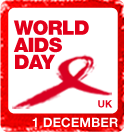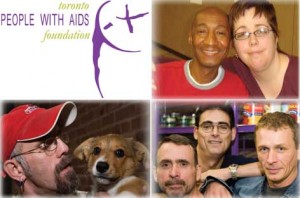 In my time outside of classes, I dedicate some of it to volunteer work that directly relates to informing people about HIV/AIDS and how to prevent infection. I do this with working at the Sexual Education and Peer Counselling Centre here on campus, and am quite familiar with the HIV/AIDS support organizations here in Toronto. I've learned over the years that in spite of all we know about HIV/AIDS, a number of myths still persist.
HIV/AIDS was first diagnosed in 1981, and was called GRID, the Gay-Related Immunodeficiency, mostly because it appeared to only effect the homosexual population. Since the early 80s, however, it has been documented in the heterosexual population, indicating that the deficiency was not gay-related.
In my time outside of classes, I dedicate some of it to volunteer work that directly relates to informing people about HIV/AIDS and how to prevent infection. I do this with working at the Sexual Education and Peer Counselling Centre here on campus, and am quite familiar with the HIV/AIDS support organizations here in Toronto. I've learned over the years that in spite of all we know about HIV/AIDS, a number of myths still persist.
HIV/AIDS was first diagnosed in 1981, and was called GRID, the Gay-Related Immunodeficiency, mostly because it appeared to only effect the homosexual population. Since the early 80s, however, it has been documented in the heterosexual population, indicating that the deficiency was not gay-related.
 Since 1982, there have been over 25 million documented deaths related to HIV/AIDS infection in the world. Currently, there are over 33 million infected (representing 0.5 percent of the world population) with the vast majority living in sub-Saharan Africa. According to the Toronto Star, there is an estimated one infected person for every 120 living in Toronto. Of that group, 87.5 percent have been male.
Now let’s tackle some of the common myths:
Myth #1 - HIV/AIDS is a gay disease.
HIV/AIDS does not discriminate between gay/straight/bi/etc. In fact, the largest population base for HIV/AIDS related deaths occurs in straight men and women living in sub-Saharan Africa.
Myth #2 - You can only get HIV/AIDS through unprotected sex.
HIV/AIDS can pass from one person to another through any fluid exchange. While condoms are quite effective for preventing transmission during sex 99.99 percent of the time, there is still a small chance of infection. Further, blood to blood contact is significantly risky. There are other slight risks, for example, if someone has brushed their teeth with a shared toothbrush and has bleeding gums, there is a risk of contracting HIV/AIDS orally. However, the virus will not pass through saliva, so quick kisses or sharing beverages have no risk.
Myth #3 - I am too young to get HIV/AIDS.
Anybody, regardless of age can become infected. In fact, in 2007 there were more than 330,000 child deaths. Infected mothers or fathers can transmit the virus when they have children.
Myth #4 - I don't know anyone with HIV/AIDS. It must not be that big a deal.
As I mentioned before, 0.5 percent of the world's population is currently infected. That means that at a school the size of the U of T, there could be a few hundred students with HIV/AIDS.
Myth #5 - So what if I get it? There is a cure.
HIV/AIDS is not the death sentence it was 20 years ago, but there is NO cure, despite what you may have heard. Related deaths have come down significantly over the years thanks to the increasing effectiveness of anti-retroviral drugs, showing that it can be treated.
Since 1982, there have been over 25 million documented deaths related to HIV/AIDS infection in the world. Currently, there are over 33 million infected (representing 0.5 percent of the world population) with the vast majority living in sub-Saharan Africa. According to the Toronto Star, there is an estimated one infected person for every 120 living in Toronto. Of that group, 87.5 percent have been male.
Now let’s tackle some of the common myths:
Myth #1 - HIV/AIDS is a gay disease.
HIV/AIDS does not discriminate between gay/straight/bi/etc. In fact, the largest population base for HIV/AIDS related deaths occurs in straight men and women living in sub-Saharan Africa.
Myth #2 - You can only get HIV/AIDS through unprotected sex.
HIV/AIDS can pass from one person to another through any fluid exchange. While condoms are quite effective for preventing transmission during sex 99.99 percent of the time, there is still a small chance of infection. Further, blood to blood contact is significantly risky. There are other slight risks, for example, if someone has brushed their teeth with a shared toothbrush and has bleeding gums, there is a risk of contracting HIV/AIDS orally. However, the virus will not pass through saliva, so quick kisses or sharing beverages have no risk.
Myth #3 - I am too young to get HIV/AIDS.
Anybody, regardless of age can become infected. In fact, in 2007 there were more than 330,000 child deaths. Infected mothers or fathers can transmit the virus when they have children.
Myth #4 - I don't know anyone with HIV/AIDS. It must not be that big a deal.
As I mentioned before, 0.5 percent of the world's population is currently infected. That means that at a school the size of the U of T, there could be a few hundred students with HIV/AIDS.
Myth #5 - So what if I get it? There is a cure.
HIV/AIDS is not the death sentence it was 20 years ago, but there is NO cure, despite what you may have heard. Related deaths have come down significantly over the years thanks to the increasing effectiveness of anti-retroviral drugs, showing that it can be treated.
 I hope this gives you a clearer understanding of HIV/AIDS. If you want to know more, there are a bunch of resources available on and off campus, such as the Sexual Education Centre (who give out free condoms), ACT, the Toronto People With AIDS Foundation, and even courses at U of T.
I hope this gives you a clearer understanding of HIV/AIDS. If you want to know more, there are a bunch of resources available on and off campus, such as the Sexual Education Centre (who give out free condoms), ACT, the Toronto People With AIDS Foundation, and even courses at U of T.
There are several events planned to increase awareness for World AIDS Day, and everyone is welcome to attend. On campus, there is Challenging Misconceptions, and interactive workshop planned for December 1st from 3-5 in UC255.
The main point is being safe, always. It only takes one opportunity to transmit the virus, so vigilance is essential. - Jon

As always, so informative Jon!
Hi Jon,
I appreciate that you volunteer to bring awareness to others. It’s sad, but reality is that many misconceptions or myths about Aids could possibly lead to someone getting Aids for not having the right information. I think your five myths are a great deal of information in a summarized form.
I recently wrote a research paper, “The end of Aids” and there’s always new information to be learned. I found out about that one patient in Berlin who was cured of Aids. That was a very amazing discovery for me as I was unaware of that. His treatment cost $100,000! It’s very unfortunate that not everyone has access to this as it is very costly. What’s your take on this?
Best Regards,
Turki Alsadoun
http://www.youtube.com/watch?v=HvXXDjL9tOs
thought i’d share some creative expression on aids. in no way do I think efforts towards aids should be halted, it is a beautiful thing to support such a cause.
have a listen.
Number 1 is misleading. While it’s true AIDS is not limited to gays, looking at the numbers, for example here: http://www.avert.org/usa-transmission-gender.htm
Homosexual men are 82% of HIV cases, where straight men are only 14%. This is despite the fact that homosexuals are a tiny minority.
Doing some math, that means a gay man is 12,000% more likely to get HIV than a straight man. Yep, that’s twelve thousand percent!
So in a very real sense, for men, AIDS is (mostly) a homosexual disease.
Hi Tru,
Thank you very much for taking the time to read and comment on my blog post. I can certainly understand the point you are making, however the information you present is solely data based on the United States, and not the world as a whole.
According to the site you reference, there are an estimated 3.4 million people living with HIV/AIDS, of which 50% are women and 10% are children (http://www.avert.org/worldstats.htm). Although the United States can be used as a prime example of case-studies in many areas, HIV/AIDS is not one of them.
Further, back to the fact I mentioned in my post, Sub-Saharan Africa is the most affected region of the world with approximately 22.9 million people living with HIV/AIDS, and, according to the same site (http://www.avert.org/africa-hiv-aids-statistics.htm) women in this region make up over 50% of current infections.
It is with these facts that I can firmly state that HIV/AIDS is not a gay disease.
-Jon
hello
yes its true that people even in the healthcare sector are still having misconceptions regarding the dreadful disease infact PLHIV are looked down upon by them.i m a post graduate student & want to inform the nurses in my locality about other route MTCT & its prevention so planned to do a research.but m facing difficulty .tried to contact many NGOs & organization.but no reply yet…can u please suggest from where can i get help[ for the same
Hi Naz,
First off, thanks for taking the time to read and respond to my post. I am not sure exactly if this will help, but these are some organizations in Toronto that provide outreach and education not only to individuals, but organizations on PHAs.
These groups I am aware of are the Toronto People With AIDS Foundation, and the AIDS Committee of Toronto.
I hope that this helps!
-Jon